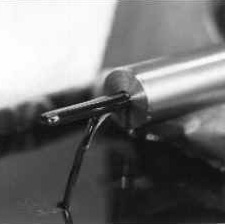- 01: Introduction
- 02: History
- 03: Propellants, Firearms, and Ammunition Development
- 04: Modern Firearms Manufacture
- 05: Small Arms Ammunition
- 06: Evidence Handling Procedures
- 07: Equipment and Instrumentation
- 08: Examination of Firearms
- 09: Cartridge and Shotshell Examination
- 10: Characterization and Evaluation of Fired Projectiles
- 11: Bullet Comparison and Identification
- 12: Gunshot Residue and Distance Determination
- 13: Toolmark Identification
- 14: Communicating Results
- Resources


Reaming
Home > Modern Firearms Manufacture > Rifled Barrels > Reaming
In spite of the great care given to making straight holes, barrel makers normally further process the bore following drilling to smooth the surface, correct minor variations in straightness, and establish the final bore diameter. The bore diameter is the minor diameter of the finished rifled barrel. A typical finished .30 caliber barrel made to Sporting Arms and Ammunition Manufacturers’ Institute, Inc.® (SAAMI) standards has a major diameter (groove-to groove) of 0.308 inches and a minor diameter (land-to-land) of 0.300 inches. Reaming is the operation of choice for finishing the bore to 0.300 inches before rifling.

Bore reamer entering the barrel
A reamer for refining a drilled bore is a long cutting tool with its working edges on the sides. The diameter of the reamer is typically the same as the final bore diameter. To assure proper alignment and straightness, the reamer is much longer, compared to its diameter. A typical reamer for this operation will have a length ten to twenty times its diameter for precision alignment. This assists in aligning the reamer as it passes through the barrel.
Reaming reduces roughness inherent in drilled holes. Because the reamer is required to remove very little metal, the working edges are finely honed. The surface of the barrel hole is smooth, yet reaming can leave markings that may ultimately be passed to a fired bullet.




